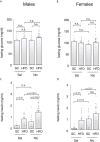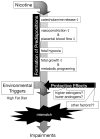Prenatal Nicotine Exposure Induces Low Birthweight and Hyperinsulinemia in Male Rats
- PMID: 34177815
- PMCID: PMC8220205
- DOI: 10.3389/fendo.2021.694336
Prenatal Nicotine Exposure Induces Low Birthweight and Hyperinsulinemia in Male Rats
Abstract
Smoking during pregnancy is one of the causes of low birthweight. Ingestion of nicotine during pregnancy has various metabolic impacts on the fetus and offspring. According to the developmental origins of health and disease theory, low birthweight is a risk factor for developing various non-communicable diseases, including diabetes. We hypothesized that when nicotine-induced low-birthweight rats, when exposed to a high-fat diet (HFD) after growth, are predisposed to glucose intolerance as a result of a mismatch between the eutrophic environment and small body size. Therefore, we investigated whether hyperinsulinemia was caused by exposure of nicotine-induced low-birthweight rats to HFD, including whether this phenomenon exhibited possible sex differences. The average birthweight and body weight at weaning day of offspring from nicotine-administered dams was lower than those of controls. The offspring from nicotine-administered dams did not show rapid fat accumulation after exposure to HFD, and weight and body fat ratio of these animals did not differ from those of the controls. Blood glucose levels did not differ between the groups, but insulin levels increased only in male HFD-exposed offspring from nicotine-administered dams. Similarly, only in HFD-exposed male from nicotine-administered dams showed decreases in the insulin receptor expression in the liver. We conclude that male rats subjected to prenatal nicotine exposure develop hyperinsulinemia when exposed to HFD after growth. Our results suggest that decreased expression of insulin receptors in the liver may be involved in the mechanism underlying hyperinsulinemia in low-birthweight offspring, a phenomenon that appeared to exhibit a sex-specific bias.
Keywords: DOHaD (development origins of health and disease); insulin; nicotine; prenatal; sex-specificity.
Copyright © 2021 Nemoto, Ando, Nagao, Kakinuma and Sugihara.
Conflict of interest statement
The authors declare that the research was conducted in the absence of any commercial or financial relationships that could be construed as a potential conflict of interest.
Figures






Similar articles
-
Vaporized nicotine in utero results in reduced birthweight, increased locomotion, and decreased voluntary exercise, dependent on sex and diet in offspring.Psychopharmacology (Berl). 2024 Sep;241(9):1857-1882. doi: 10.1007/s00213-024-06602-z. Epub 2024 May 11. Psychopharmacology (Berl). 2024. PMID: 38733527
-
Maternal cigarette smoke exposure contributes to glucose intolerance and decreased brain insulin action in mice offspring independent of maternal diet.PLoS One. 2011;6(11):e27260. doi: 10.1371/journal.pone.0027260. Epub 2011 Nov 4. PLoS One. 2011. PMID: 22076142 Free PMC article.
-
Synergistic effects of prenatal nicotine exposure and post-weaning high-fat diet on hypercholesterolaemia in rat offspring of different sexes.Basic Clin Pharmacol Toxicol. 2019 Jun;124(6):730-740. doi: 10.1111/bcpt.13187. Epub 2019 Jan 10. Basic Clin Pharmacol Toxicol. 2019. PMID: 30549443
-
Maternal antioxidants prevent β-cell apoptosis and promote formation of dual hormone-expressing endocrine cells in male offspring following fetal and neonatal nicotine exposure.J Diabetes. 2012 Sep;4(3):297-306. doi: 10.1111/j.1753-0407.2012.00195.x. J Diabetes. 2012. PMID: 22385833 Free PMC article.
-
Prenatal Testosterone Exposure Leads to Gonadal Hormone-Dependent Hyperinsulinemia and Gonadal Hormone-Independent Glucose Intolerance in Adult Male Rat Offspring.Biol Reprod. 2016 Jan;94(1):5. doi: 10.1095/biolreprod.115.133157. Epub 2015 Nov 19. Biol Reprod. 2016. PMID: 26586841 Free PMC article.
Cited by
-
Vaporized nicotine in utero results in reduced birthweight, increased locomotion, and decreased voluntary exercise, dependent on sex and diet in offspring.Psychopharmacology (Berl). 2024 Sep;241(9):1857-1882. doi: 10.1007/s00213-024-06602-z. Epub 2024 May 11. Psychopharmacology (Berl). 2024. PMID: 38733527
-
Xenobiotics Delivered by Electronic Nicotine Delivery Systems: Potential Cellular and Molecular Mechanisms on the Pathogenesis of Chronic Kidney Disease.Int J Mol Sci. 2022 Sep 7;23(18):10293. doi: 10.3390/ijms231810293. Int J Mol Sci. 2022. PMID: 36142207 Free PMC article. Review.
References
-
- Arima K, Kasai Y, Sugimoto M, Marui E, Minematsu K. Risk Factors for Low Birth Weight Infants in Japanese Pregnancies: A One-Year Study of 2551 Cases in Tokyo. Int J Pediatr Neonatal Care (2017) 3:IJPNC–122. 10.15344/2455-2364/2017/122 - DOI
Publication types
MeSH terms
Substances
LinkOut - more resources
Full Text Sources
Other Literature Sources
Medical

